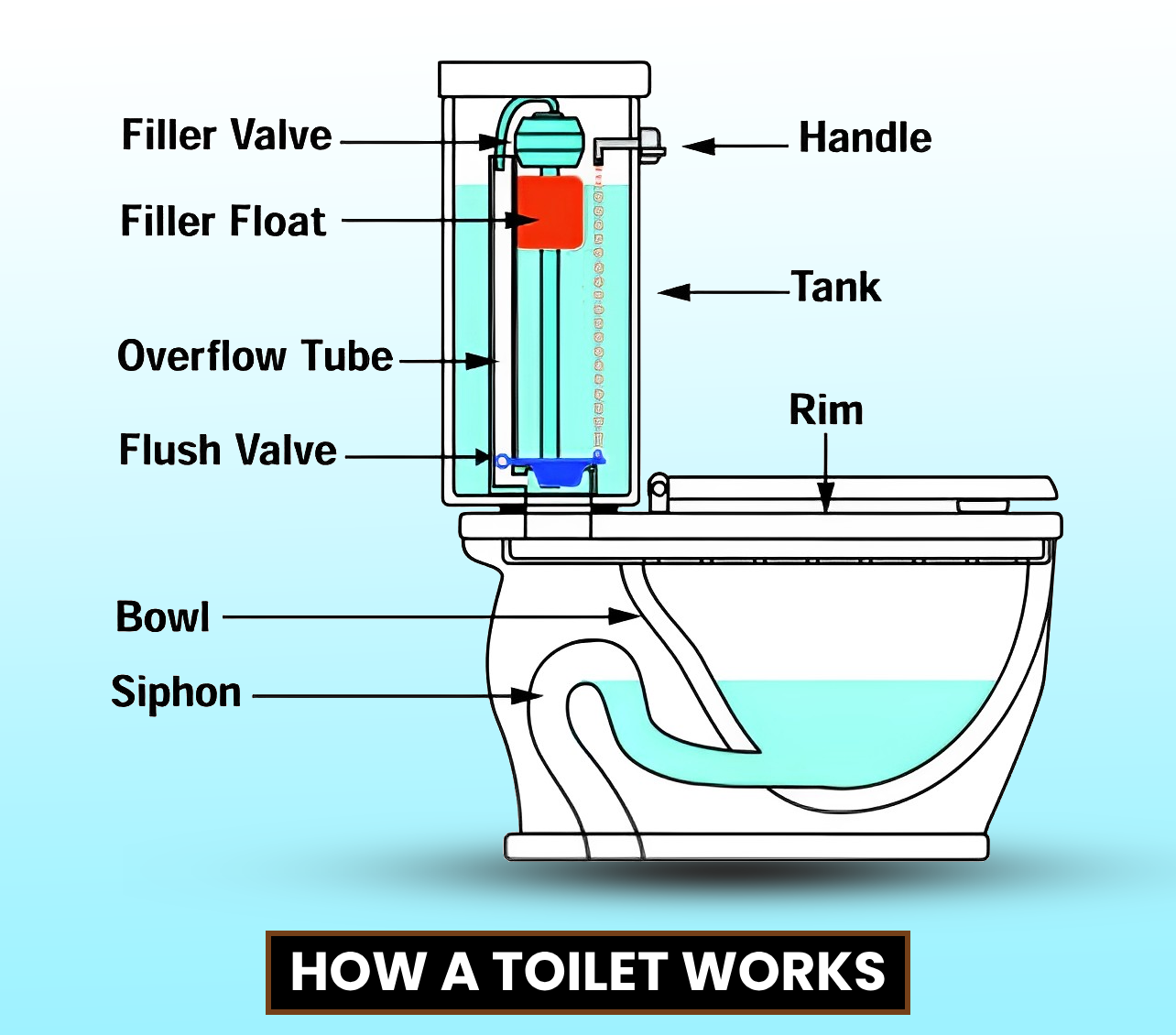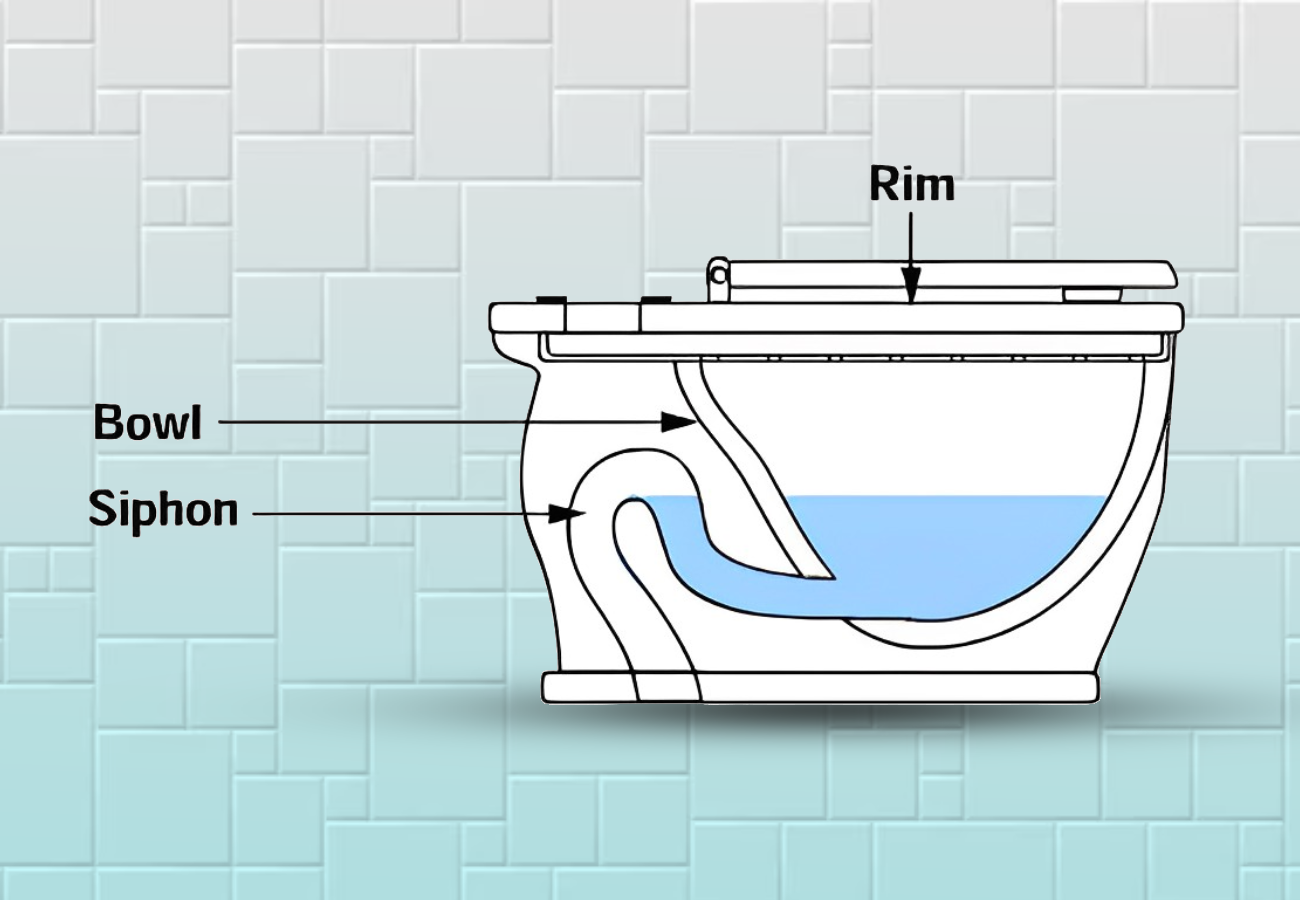HOW A GRAVITY FED TOILET WORKS
The toilet. The commode. The john. The loo. The porcelain throne. No matter what you call it, it is inevitable that we come to discuss this device, because every home has at least one. But more important, we'll discuss the toilet because it is a technological marvel -- a fascinating water handling system!

Parts of a Toilet
There are several interrelated components that make a toilet do what it does, as shown here:
If you take off the tank cover and peer inside, you will see all of these parts. They might look slightly different in your particular toilet, but they are all there in one form or another. The three main systems that work together are:
- The bowl siphon
- The flush mechanism
- The refill mechanism
Let's look at each of these parts separately until the secrets of the toilet are revealed.

The Bowl Siphon
Let's say that you somehow disconnected the tank, and all you had in your bathroom was the bowl. You would still have a toilet. Even though it has no moving parts, the bowl solves all of the problems a toilet needs to solve. The crucial mechanism that is molded into the bowl is called the bowl siphon, shown here:
You can understand how the siphon works by trying two experiments with your toilet. First, take a cup of water and pour it into the bowl. You will find that approximately nothing happens. What's even more interesting is that you can pour 25 cups (6 L) of water into a toilet, one at a time, and still, nothing will happen. That is, no matter how many cups of water you pour in, the level of the water in the bowl never rises. You can see in the figure why this is the case. When you pour the cup of water in, the water level in the bowl rises, but the extra water immediately spills over the edge of the siphon tube and drains away.
Now, take a bucket of water -- approximately 2 gallons (7.6 L) -- and pour it into the bowl. You will find that pouring in this amount of water causes the bowl to flush. That is, almost all of the water is sucked out of the bowl, and the bowl makes the recognizable "flush" sound and all of the water goes down the pipe. What's happened is this: You've poured enough water into the bowl fast enough to fill the siphon tube. And once the tube was filled, the rest was automatic. The siphon sucked the water out of the bowl and down the sewer pipe. As soon as the bowl emptied, air entered the siphon tube, producing that distinctive gurgling sound and stopping the siphoning process.
You can see that, even if someone were to cut off the water to your bathroom, you could still flush the toilet. All you need is a bucket containing a couple of gallons of water.
The Flush Mechanism
The purpose of the tank is to act like the bucket of water described in the previous section. You have to get enough water into the bowl fast enough to activate the siphon. If you tried to do that using a normal house water pipe, water would not come in fast enough -- the siphon would never start. So the tank acts as a capacitor. It holds several gallons of water, which it takes perhaps 30 to 60 seconds to accumulate. When you flush, all of the water in the tank is dumped into the bowl in about three seconds -- the equivalent of pouring in a bucket of water.

There is a chain attached to the handle on the side of the tank. When you push on the handle, it
pulls the chain, which is connected to the flush valve. The chain lifts the flush valve, which then floats out of the way, revealing a 2- to 3-inch (5.08- to 7.62-cm) diameter drain hole. Uncovering this hole allows the water to enter the bowl. In most toilets, the bowl has been molded so that the water enters the rim, and some of it drains out through holes in the rim. A good portion of the water flows down to a larger hole at the bottom of the bowl. This hole is known as the siphon jet. It releases most of the water directly into the siphon tube. Because all of the water in the bowl enters the tank in about three seconds, it is enough to fill and activate the siphon effect, and all of the water and waste in the bowl is sucked out.
The Refill Mechanism
So the bowl will flush as long as we dump enough water into it to activate the siphon. And the
purpose of the tank and the flush valve is to hold and then dump about 2 gallons (7.6 L) of water
very quickly into the bowl. Once the tank has emptied, the flush valve resituates itself in the
bottom of the tank, covering the drain hole so the tank can be refilled. It is the job of the refill
mechanism to fill the tank back up with enough water to start the whole process again.

The refill mechanism has a valve that turns the water on and off. The valve turns the water on
when the filler float (or ball float) falls. The float falls when the water level in the tank drops.
The filler valve (or refill valve) sends water in two directions, as shown in this figure:
Putting It All Together
Now that you have seen all the parts, you can understand the complete mechanism:
- Pushing on the handle pulls the chain, which releases the flush valve.
- About 2 gallons (7.6 L) of water rush from the tank into the bowl in about three seconds.
The flush valve then reseats. - This rush of water activates the siphon in the bowl. The siphon sucks everything in the
bowl down the drain. - Meanwhile, when the level of the water in the tank falls, so does the float. The falling float turns on the refill valve.
- Water flowing through the refill valve refills the tank as well as the bowl. As the tank
refills, the float rises, and when it reaches a certain level the refill valve shuts off. - Should something go wrong and cause the refill valve to keep running, the overflow tube prevents a flood.
Smarter Flush Systems
The Smarter Flush dual flush toilet conversion kits use approximately one gallon of water for liquids and paper and approximately two gallons for solids. This will save thousands of gallons of water each year and the system will pay for itself in a few months. Smarter Flush eliminates the leaky flapper and troublesome chain and at the same time improves the power of the flush. The Smarter Flush Quick Connect installs in most toilets in ten minutes or less without tools.
